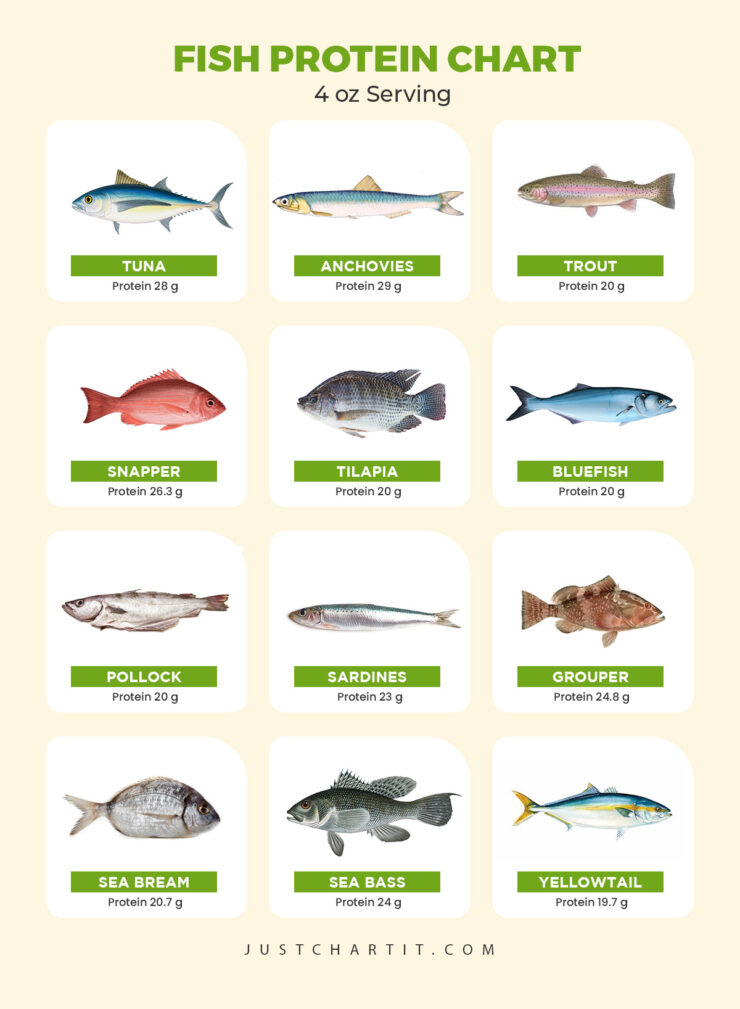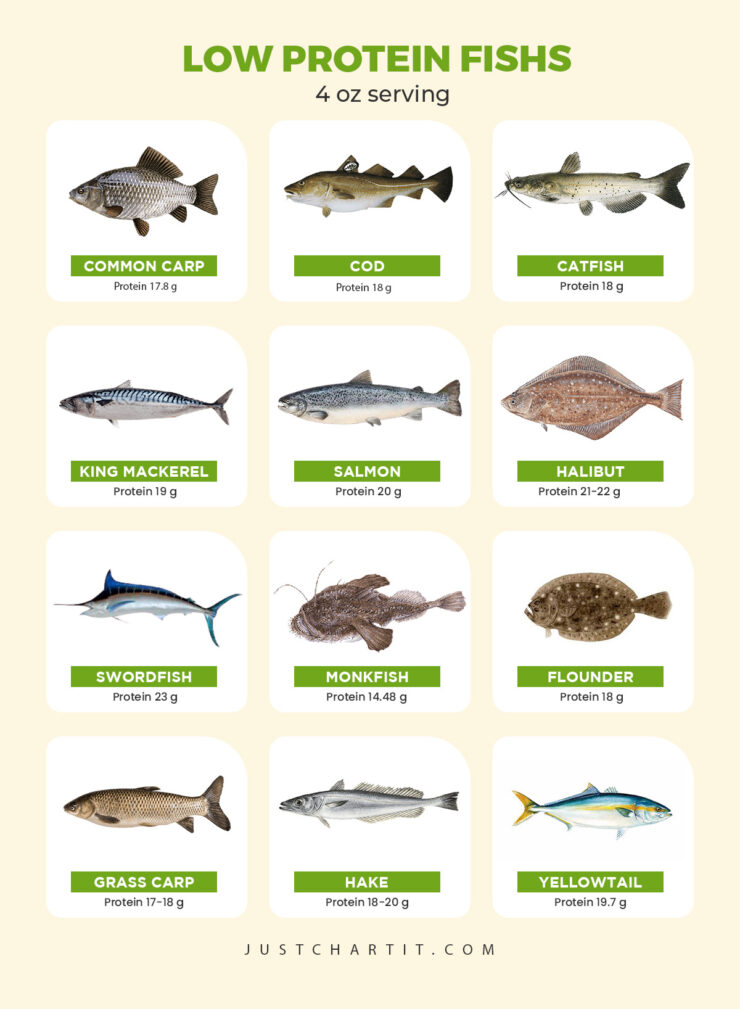Protein is crucial to maintaining good overall health and numerous other benefits. It’s also required for muscle building and repair, blood sugar regulation, and more. People often resort to a protein diet to lose weight.
Fish is often neglected as a protein despite its high protein content. Also, it’s a high-quality protein because it contains all the crucial amino acids our body needs. In many cultures, fish is a staple food, so they might think they are not getting enough proteins.
Fish is high in micronutrients, but the best part is its low calories, making it the best food choice for people aiming to lose weight. Low carbohydrates in the fish make it the best option for a low-carb diet such as the Ketogenic diet.
Tempted enough to know what this wonder food has in store for you? Let’s continue as we share the fish with the most protein in our fish protein chart below.

Highest Protein Fish
Whether you want to gain muscles or simply increase the protein in your diet, you should know that all seafood has varying amounts of protein. Health authorities recommend having a variety of protein-dense meats to benefit from a protein-rich diet fully.
Seafood and fish have a high protein content and are mostly low in fat, making them ideal food for a protein-rich diet. Fish high in protein can help produce hormones and enzymes that help with the body’s various functions.
You can consume one or two 4-ounce fish servings daily to increase protein. This will give you around 18 to 30 grams of protein for one serving of fish, depending on which type you are consuming.
The chart below illustrates the fish protein amount for 4 ounces serving various fishes. It’s best to know fish protein percentages to compare them and use them to plan your meals. One piece of fish protein will also vary based on its cooking method.
| Fish Variety | Protein Content (4 oz serving) |
|---|---|
| Tuna | 28 |
| Anchovies | 29 |
| Trout | 20 |
| Snapper | 26.3 |
| Tilapia | 26 |
| Bluefish | 20 |
| Pollock | 20 |
| Sardines | 23 |
| Grouper | 24.8 |
| Sea Bream | 20.7 |
| Sea Bass | 24 |
| Yellowtail | 19.7 |
| Common Carp | 17.8 |
| Cod | 18 |
| Catfish | 18 |
| King Mackerel | 19 |
| Salmon | 20 |
| Halibut | 21-22 |
| Swordfish | 23 |
| Monkfish | 14.48 |
| Flounder | 18 |
| Grass Carp | 17-18 |
| Hake | 18-20 |

Low Protein Fish List
The United States Food and Drug Administration (FDA) and the Environmental Protection Agency (EPA) recommend consuming 2-3 servings of various fish per week. Fishes are generally good protein sources; however, some have less protein but are rich in vitamins and minerals.
Either way, it’s advisable to consume at least two portions of fish in a week, including one part of oily fish, to benefit from the goodness of the fish. Generally, fish with lesser proteins also have fewer calories so you can use them in low-calorie diets.

People like Dr. Mike Roussell frequently express their expert advice on consuming fish for its protein content and health benefits.
If you still need to be convinced about consuming enough fish in your diet, check out his work for motivation. Here’s a list of some of the fish low in protein but rich in other vital minerals and nutrients:
| Fish Variety | Protein Content (4 oz serving) |
|---|---|
| European Anchovy | 17 |
| Cuttlefish | 18.4 |
| Grass Carp | 19 |
| Hake | 18 |
Best Fish For Protein And Omega 3
Fishes are divided into two types: oily and white; you can safely consume as many proportions of white fish as you want. On the contrary, you must be cautious and consume less oily fish as their pollutants may harm your body.
Most fishes are undoubtedly rich in protein and Omega 3 fatty acids. Knowing the nutritional content of different fishes can help reduce exposure to environmental pollutants like mercury and allow you to pick fish according to your requirements.
People who use these fishes religiously in their meals have a lower chance of experiencing heart problems. As the Famous POlitician Oscar Arias said, “The most deadly disease truly is the failure of the heart,” so why not eat healthy to live a better life?
People with heart problems can use the table below that illustrates fish protein per 100g, fish calories, and Omega 3 content of fish:
| Fish Variety | Omega-3g | Calories | Protein |
|---|---|---|---|
| Herring | 1.7 | 158 | 18 |
| Salmon | 2.3 | 142 | 20 |
| Mackerel | 4.1 | 161 | 25 |
| Sardines | 1.5 | 208 | 25 |
| Anchovies | 1.64 | 210 | 29 |
| Halibut | 0.5-1 | 90 | 19 |
| Rainbow Trout | 0.9-1.2 | 119 | 20 |
| Tuna | 1.6 | 130 | 28 |
Also read: Fish Taste Chart
Indian Fish Protein Chart
Fish holds nutritional, culinary, and cultural significance in India, and Indians love to eat fish. It’s a popular choice among people looking for healthier meat options. India has a long coastline; hence it’s home to several delicious fish that are a warehouse of protein and other vital nutrients.
People in Goa, West Bengal, and Kerala highly depend on fish as a source of nutrients and protein. The good news is that they are taking advantage of all critical nutrients when relying on fish for their nutritional needs. The Daily Recommended Value for protein for an average man is 56 grams and 46 grams for a woman.
The table below explains the protein in fish per 100g found in India; you can see that most fishes fulfil half or at least one-third of the protein the body needs.
| Fish | Protein per 100g |
|---|---|
| Rawas (Indian Salmon) | 25-26 |
| Surmai (Seer Fish / King Mackerel / King Fish) | 26 |
| Rani (Pink perch) | 25 |
| Katla (Indian Carp or Bengal Carp) | 23 |
| Hilsa (Herring / Indian Shad / Ilish) | 21 |
| Pamphlet (Pomfret / Indian Butter Fish) | 18 |
| Rohu (Roho or Carpo Fish) | 17 |
| Bangda (Indian Mackerel) | 17 |
FAQs
Which has more protein, chicken or fish?
One hundred grams of chicken breast contains 31 grams of protein which is more than some of the best fishes for protein, including Anchovies, Salmon, Tuna, and Snapper. However, Fish are considered healthier options as they are not just good protein sources but are also packed with other vital nutrients such as Omega-s.
Which is better, protein, fish or egg?
Eggs and fish are good protein sources; one large egg contains 6 grams of protein and 70-80 calories. You’ll have to eat three to four eggs to get the same protein as 100g Tuna or Anchovy. Hence, it’s safe to say that fishes are better protein sources than eggs.
Which has more protein, milk or fish?
One cup of milk contains only 8 grams of protein, and a 3-ounce piece of fish has twice or thrice this amount. Hence, If you want more protein, add more fish over milk.
Final Words
Fish is a beneficial food that should be added to meals; pairing them with colorful veggies is a smart way to encourage youngsters to enjoy their fish meal. However, if you need more fish, you can take fish protein powder or fish oils to fulfill your dietary requirements.
If you have access to various types of fish, you can refer to the fish protein content chart above to benefit from the nutritional value of the fish.
